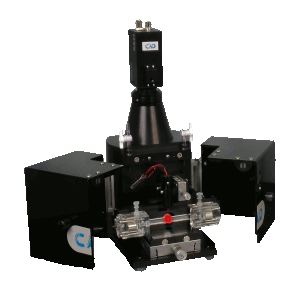Zetameter Zetacompact
Zeta Potential using the technique of micro-electrophoresis
Description - Principle
ZetaCompact is a zetameter based on the micro-electrophoresis, i.e. coupling direct observation (microscopy) and particles motion under an applied electric field (electrophoresis). Illumination of the measuring cell is done by a laser sheet or Single Plane Illumination Microscopy generated by the combination of lenses and a laser. This technique allows an observation in a single vertical plane.
To determine Zeta Potential, this plane must correspond to the stationary layer which is accurately located and controlled. Particles motion is recorded with a high sensitivity digital camera.
Electrophoretic mobilities distribution is thus measured using a novel tracking algorithm optimized to follow up to 5 000 tracks/sequence. Based on digital images correlation, this algorithm offers a more accurate and sensitive determination of Zeta Potential, either in dilute or semi-diluted systems.
Specifications
ZetaCompact measures in live the following parameters, relevant in the determination of Zeta Potential:
Electrophoretic mobility: - 15 to +15 µms-1 /Vcm -1
Applied electric field: 0 to 250 V
Conductivity: 0,01 to 100 mScm -1
Particles size range: 0 to 30 µm
Concentration: 1 to 10 000 ppm
pH: 2 to 12
Applications
Numerous applications of ZetaCompact end-users concern mainly the following activities:
Suspensions-Emulsions-Bacteria-Proteins-Nanoparticles
Particle tracking velocimetry (PTV) is a velocimetry method to determine the velocity of particles suspended in a liquid. With over 20 years of experience in PTV, CAD Instruments implemented a new algorithm based on digital image correlation to improve zetameters accuracy.
Contact us!
Principle

